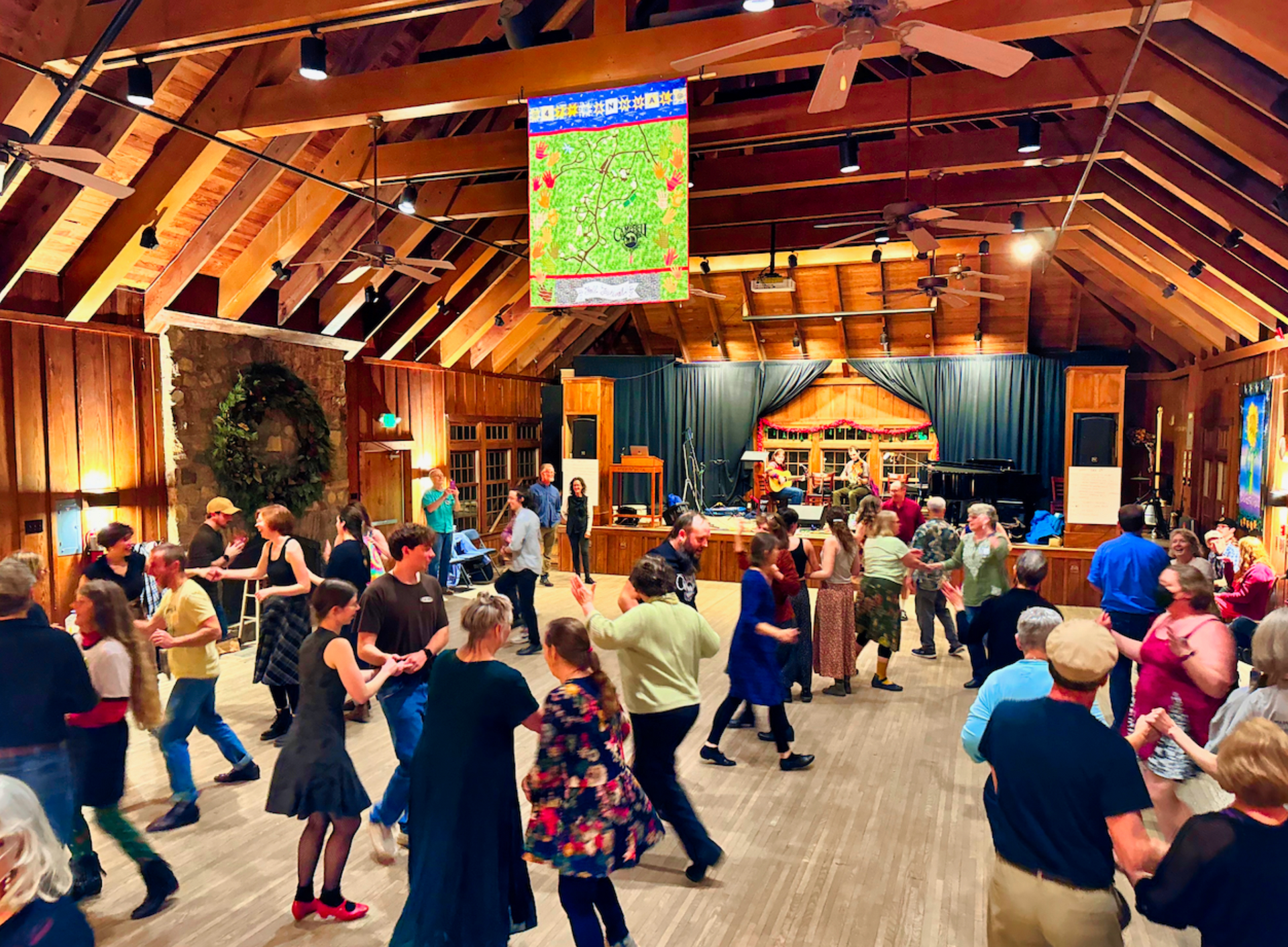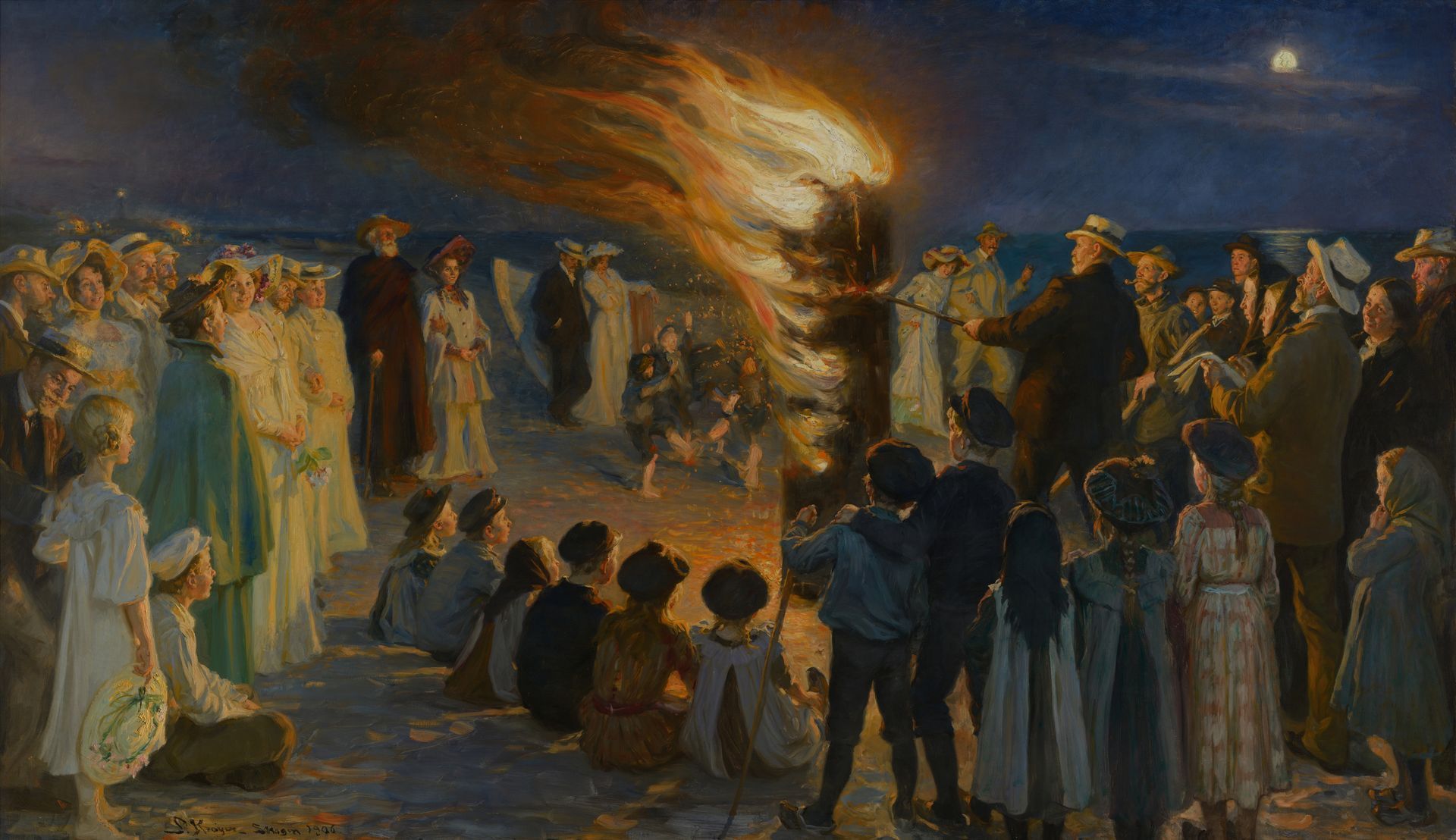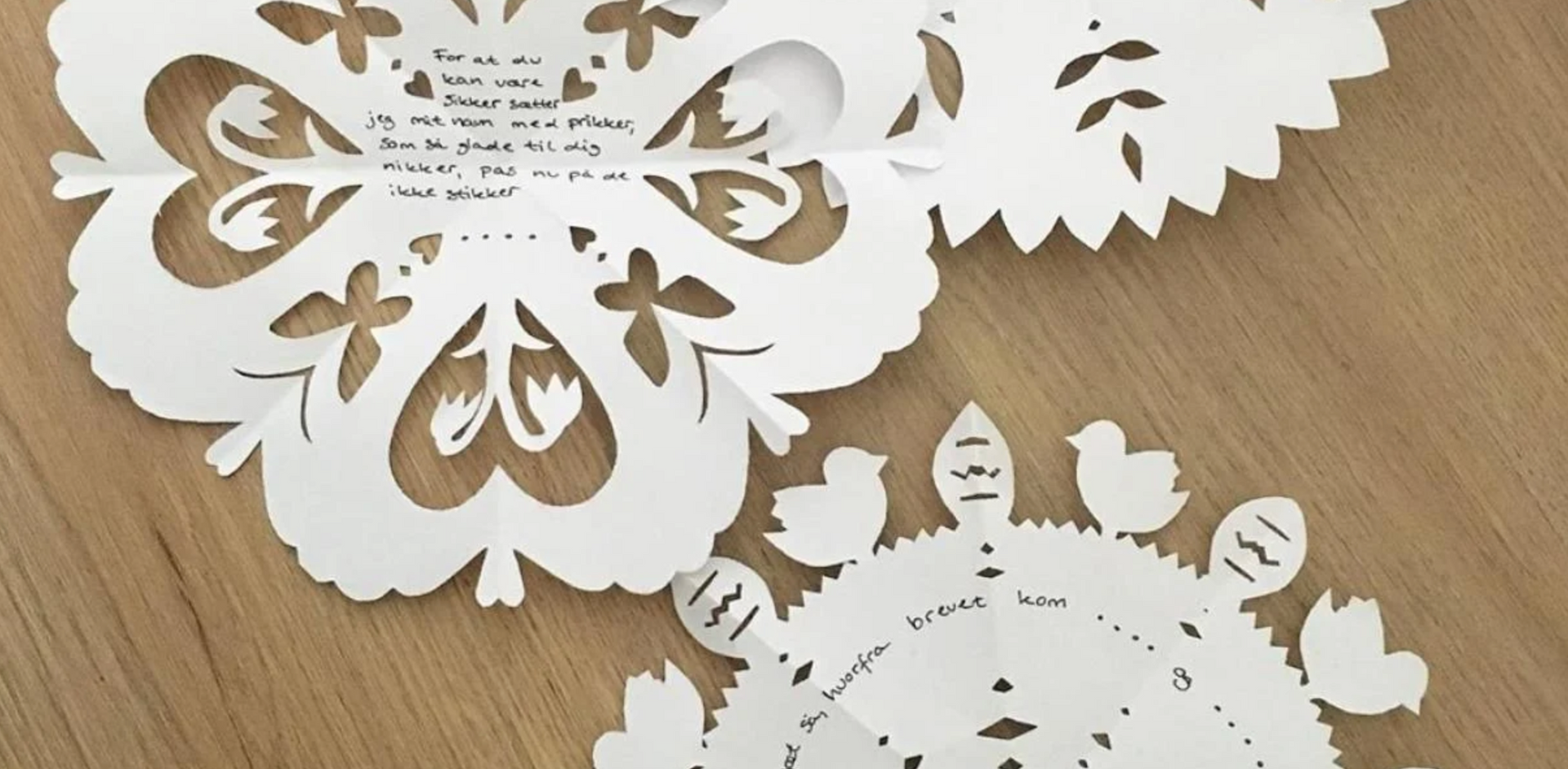October 2025
Church and Life
Volume LXXIV, Number 5
Welcome to the October 2025 Issue!
This issue of Church and Life celebrates Autumn and the changing of the seasons-- of culture and memorable events of the church and community calendar and of life and milestones in individual experience. We open with "Tak, Tusind Tak," the theme song by Bryan Odeen for the Danebod Folk Camp and a "Harvest Sermon," offered by Pastor Anne-Grethe Krogh Nielson from The Danish Lutheran Church in Yorba Linda, California. Because this is also the season for folk meetings, we include reports about both Danebod Folk Camp and Danebod Folk Meeting. Marilyn Gift reports on what happened at the 2025 Folk Camp. Steve Olsen writes about the deeper tensions that make Folk Meeting the rich and rewarding experience that it is. Kay Linquist tells about the rich, happy life of Joy Ibsen and how her character exemplifies Danebod. In this issue's "Dateline Denmark," Edward Broadbridge reports on Henrik Bredmose Simonsen's documentation of life among the “Grundtvigian” Danish Americans. And then we shift to articles related to the 100th Anniversary of the John C. Campbell Folk School in Brasstown, North Carolina. Madison Morrison reports on the life and legacy of Olive Campbell, the founder of the folk school. Maddie Benton shares a conversation she had with Chris Spicer, who worked at John C. Campbell and later became the director of the Folk Education Association of America. Ana Wright reviews Joy Ibsen's book Pandemic Parables and the New Paradigm. We close with a Postscript by the editor, Brad Busbee.
As always, we want to thank our generous supporters and contributors. We hope to feature stories about Winter and Christmas traditions and memories in the next issue. Please send us your articles!
Special thanks go to The National Foundation for Danish America, which generously shares information about this publication in its own newsletter. We also appreciate those who provide financial support, as well as who those submit articles for publication. We look forward to hearing from you!
"Tak, Tusind Tak"
By Bryan Odeen
Long ago there was a dream
to learn and serve and live deeply
Built a foundation for our formation
not knowing where the dream would lead.
Chorus
Tak, tusind tak for the past,
for the ancestors
and the stories that we have!
Tak, tusind tak, for today,
And the lessons that we carry on our way!
So today we gather still
To make community be real
Our past and future coming together
Still sharing what our hands have built.
Chorus
So the journey will continue
Long after we are gone
And the future will still have space,
Maybe they will sing along.
Note: This was the theme song for the 2025 Danebod Folk Camp that Marilyn Gift writes about below.
Harvest Sermon: Say A Little Prayer and Count Your Blessings One by One
By Anne-Grethe Krogh Nielson

Psalm 104:
1. Bless the Lord, O my soul. O Lord my God, you are very great. You are clothed with honor and majesty,
10. You make springs gush forth in the valleys; they flow between the hills,
11. giving drink to every wild animal; the wild asses quench their thirst.
12. By the streams the birds of the air have their habitation; they sing among the branches.
13. From your lofty abode you water the mountains; the earth is satisfied with the fruit of your work.
14. You cause the grass to grow for the cattle, and plants for people to use, to bring forth food from the earth,
15. and wine to gladden the human heart, oil to make the face shine, and bread to strengthen the human heart.
24. O Lord, how manifold are your works!
33. I will sing to the Lord as long as I live; I will sing praise to my God while I have being. Bless the Lord, O my soul. Praise the Lord! AMEN
This Psalm from the Old Testament is a jubilant praise of God, all creation, this world we live in, and the daily blessings that we encounter. Psalm 104 is a joyous song and a grateful prayer for everything that has been given to us: creation, nature, streams, oceans, harvest, and abundance. Yes, even the wine to gladden and the baked bread to strengthen the human heart.
"Say a little prayer and count your blessings one by one . . ." is a line from a wonderful song by Sir Elton John and Brandi Carlile on their new album Who believes in Angels? The line of the song “A Little Light” has been ringing in my ears these past weeks, as I have been feeling the weight of fear and frustration, anger and apathy in a time where we so often are discouraged and forget to say our prayers and count our blessings.
In "A Little Light," Elton John acknowledges the uncertainty and division that makes it hard to count our blessings, but he offers a new perspective:
I see the sorrow in the headlines.
And the worry on your face
I guess it is no fun to have a heart.
While we are living through these days
But there is still a lot of beauty.
Dancing circles round this place
That is why we are gonna get up.
Point our chin toward the sun!
Say a little prayer!
and count our blessings one by one
Do not hide yourself away!
Do not grow hard from what you have heard!
You gotta break your heart wide open.
Let a little light into the world.
Today, we break our hearts wide open to listen, to celebrate, and to be in the sacred moments of prayer, baptism, and faith. Today, we let a little sparkling light into a world that desperately needs light, beauty, beginnings, and goodness. We celebrate this new light, however it comes into the world. Sometimes we receive it as parents and family and friends. Just this morning, a new little life came to church to be blessed, to be called, to be prayed over and to be counted as a blessing to us and to the world. Today, we point our chins towards the sun, we break our hearts wide open and let light and love mark this moment and day. And then we say a little prayer and count our blessings one by one.
It is Sunday. It is time to celebrate hopeful baptism and blessed beginnings. It is Harvest Sunday. It is the time of year when we celebrate the harvest, the abundance that we live in, and count the many blessings in our lives. I love this season and the celebration of harvest as it is our reminder to be thankful, mindful, and grateful for all the blessings that come to us. We sing about this in our beautiful harvest hymns; we think about it when we might recall the time of harvest in Denmark.
The Danish Philosopher Soren Kierkegaard lived most of his life in Copenhagen with his eyes focused on his writings and his nose buried in books, but he had a profound appreciation for Fall.
He wrote, “I much prefer autumn to spring because in the autumn one looks at heaven – in the spring at the earth.” Kierkegaard wisely observed that during spring we are constantly looking at the green sprouts, the blooming flowers, the signs of new life, while in Fall we look to the blue heavenly skies. In that direction we look further with faith and appreciation–with prayer and a sense of blessing.
I once read some advice for preaching sermons on harvest season when you’re not a farmer: "Don’t pretend to be a farmer if you are not. Preach from what you know and how your experiences and relationships have shaped you."
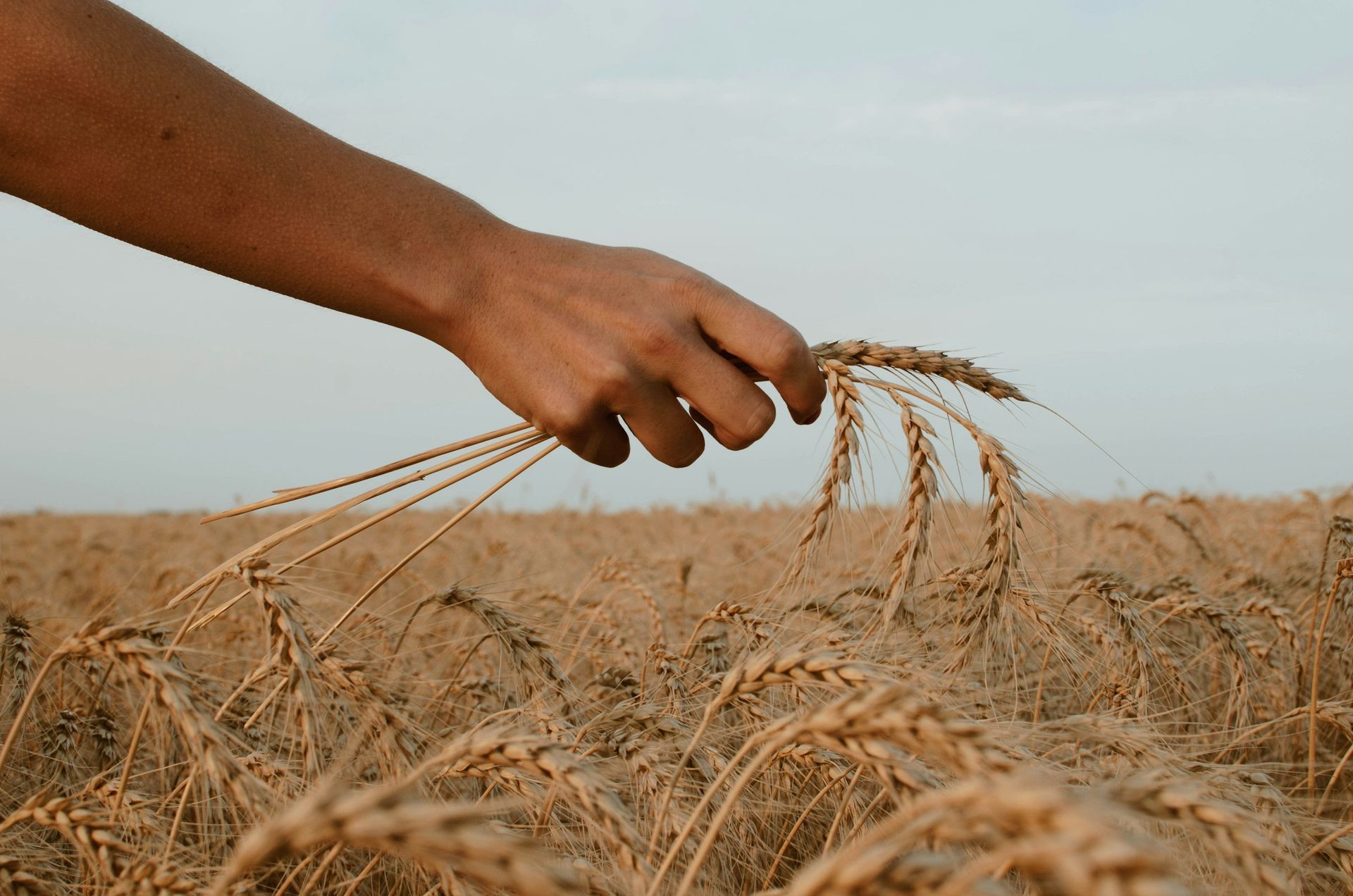
Well, I am certainly not a farmer, but I am a farmer's daughter. My father was a farmer and both of my grandfathers were farmers, and according to our ancestry book I am part of a long line of farmers that date back to Denmark in 1500. So I might not be a farmer, but I have farmers' blood in my veins and, as a result, I love the season of harvest.
As a child, I found nothing better than when the blue August and September skies were endless and high– when the air was fresh and smelled of grain, hay, and earth and when we were allowed to jump in the hay, hold the golden grains in our hands and slip it through our fingers and eat grains from the abundance of harvest.
The taste and smells of harvest are strong and intoxicating. The smell of grain and hay is one of the loveliest smells to me: It reminds me of autumn, work, and family. Images of golden fields, culled fields, stacks of hay and grain. It's a reminder of happiness, blessings, and prayers.
I am holding some wheat straws. You can smell and taste it, and you know it is part of the bread we will share later.
There is also something sad about harvest, grain, and flour. It tells the story of a summer now gone. It is the story of us and our lives, that we too will wither like the grass and grains. But it is also hope. It can be shared with the hungry. It points us to a new season of Fall and winter with light and presence, and then a new spring and new summer, a new harvest.
Life never just ends. . . Maybe that is something we need to remember and live by. We may be afraid of dying and the day of doom, but we are told that life does not stop; it continues. In our daily lives, a little child is hope that stretches far into the future, further than we can see and imagine. Jesus himself says that he is like a grain of wheat, lain into the earth to die so that give new life that may sprout and grow.
I am old enough to remember placing hay stacks on the wagon to transport them back to the farm. I will not pretend that I did any of the hard work, lifting and stacking. I was just a child. But I witnessed it and knew the importance of doing it correctly. If done otherwise, the stack would fall from the wagon as it travels along rocky or hole-filled paths and it would not be much fun being a small girl sitting on top of the stack!
Life can be rocky, uneven, and filled with holes. Sometimes, the road will sway dangerously. Strong foundations need to be laid. We have to try to give our lives the foundation of faith so we can mange holes along the way. It is about sowing and harvesting love, compassion, our fundamental faith, and joy and having them ingrained in our hearts.
The marvelous Sir Elton John and Brandi Carlile close their song with these words:
There is such a fine line between faith and apathy
Pain can put you on your feet or bring you to your knees
If you are locked inside the end of days and darkness pulls your mind
Bend the bars and hold the fire let every corner shine
That why we are gonna get up
and let a little light into the world
And sing into the darkness like a Sunday morning bird.
So, let us sing into the today, despite the fear and the division of our times, like strong Sunday morning birds full of hope, full of faith, and love. May we be filled with the bluest skies of October and faith.
Let us say a little prayer and count our blessings one by one.
Amen
A Report on the Danebod Folk Camp, August 2025
by Marilyn Gift
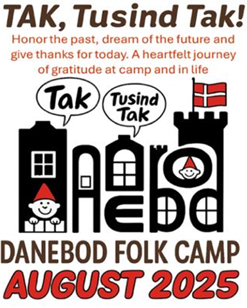
“Tak, Tusind Tak!” was the theme (and theme song) for Danebod Folk Camp this year. It was chosen to honor those who walked before us: the dreamers, the builders, the story tellers, and those that dreamed of a place like Danebod. The Danebod Folk School and campus is truly a special place where we can come together as a community of friends and family.
People of all ages, from small children, to teens, parents, grandparents, first time and longtime campers—all came from across the country to enjoy this unique Grundtvigian experience during the first week in August.
This year’s notebook was written by Jens and Elsa Kasten and dedicated to the memory of Dick Juhl and Paul Laursen. Dick Juhl was remembered for his unique sense of humor. With Rita at the piano, his wonderful bass voice led us in singing. He helped all his kids and grandkids cherish their Danish heritage. Paul Laursen was also remembered for almost 50 years of driving their camper from Indiana to Tyler, MN. His favorite song was This is a song for all the good people, all the good people who’ve touched up my life. This is a song for all the good people I’m thanking my stars for tonight. Paul remarked that there are hundreds of good people who influence the world and our lives. He was one of them and a dear friend of ours.

A typical day begins for the “early risers” with golf at 5:45 and morning gymnastics at 7:00. The rest of us gather for breakfast at 7:30 followed by morning singing at 8:45. Our talented leaders were Sonja and Matt Noykos and Karri Nussle. We sing from Favorites from the World of Song and from a printed song sheet including more popular songs.
This year, Emily Quartemont led the family dancing in the gym hall at 8:45 am. It was a great opportunity for the kids to learn and enjoy fun dances with older kids, parents, and grandparents.
In true Grundtvigian tradition of lifelong learning, discussion in the lecture hall began at 10:30 am, and each day featured a special event.
On Monday afternoon, “Crafting in Community” was led by Laila Simon and Kate Running, newcomers who shared their talents of fiber arts and needle felting.
On Tuesday, “Appreciating the Contrasts of Chinese Culture” was led by Katrina Mitchell. Katrina is our granddaughter who started coming to camp with us when she was three years old. She has been teaching English to preschoolers in Datong, China, since February. She recently returned to Datong and will continue teaching through January. The cultural contrasts she shared included pictures of squat toilets. This of course led to a campfire skit: “Where is the grab bar”? “Where is the toilet paper”?
On Wednesday, fourteen campers each gave a “60 second lecture." Bragging rights for one year went to the person whose lecture was closest to 60 seconds.
On Friday, Marie Bruun led a discussion titled “I Think You’re Wrong, But I’m Listening: Having Conversations Across the Political Divide.” As I reflect on what was said, I feel it is up to each of us to focus on “all of the above” media sources, even though the sources don’t align with our political views. If we all accept that responsibility, our country will be less divided and more hyggelig.
Each day, the dinner bell rangs at 12:00. Sarah Nussle and other campers led grace before each meal. The people on campfire duty went first in line, took their lunch to the pavilion and planned the skit for evening campfire. A nisse clue was read, and the hunt began for the hidden nisse. This year, it wasn’t found until Thursday. The food was always great, sometimes Danish medisterpølse, frikadeller, rødkål, and typical American cuisine. On Tuesday morning, Svend and Grethe Petersen baked æbleskiver. Mange Tak!
At 1:00 pm, the kids gathered in the gym hall for youth gymnastik led by Britta Petersen and Hazel Hein. 1:30 pm was craft time. There were a lot of great creative opportunities for all ages. This year’s crafts included tie dye, copper enameling, woodworking, fused glass ornaments, friendship bracelets, Danish heart baskets, pottery, knitting and needle felting, whirly toy, pipestone jewelry, stomp rockets, a variety of children’s crafts, youth RC Club and the famous “egg drop” from the tower. If you didn’t find something to do, you could participate in a cribbage tournament or naptime craft.
3:30 pm was Teatime in the dining room with brief presentations by some of the campers. Free time followed with many going to the Tyler swimming pool or hanging out under the trees. Happy hour was a time to bring out the lawn chairs and enjoy snacks, beverages, and friendly conversations.
Supper time at 6:00 pm was followed by evening singing at 7:00 in the lecture hall. Wow! It is always quite impressive and so much fun when we all sing together with gusto.
Here was one of our theme songs for the gathering:
Tapestry (Bryan Odeen)
Every summer, down in Tyler,
Call it magic I suppose.
Where we gather with each other,
at a place called Danebod.
It’s more than singing,
more than dancing,
more than extra time to eat.
It’s a time, where for a few days,
We create community.
Chorus
It’s a tapestry featuring you and me.
Each have a fiber, and each belong.
It’s a tapestry, what a sight to see.
We look for it all year long.
Learning culture from each other,
Each have something they can share.
Making mem’ries, crafting friendships,
Seems there’s music everywhere.
Chorus
Grab your lawn chair,
find some good shade,
we have space to share right here.
We’ll continue conversations
When we meet again next year.
Campfire in the pavilion began at 8:30 pm. A group of campers of all ages were selected to put on a skit. With creative input from kids and teenagers they showcased their talents with amazing skits. The lights were turned off and the spontaneous singing began as the sun set in the west and the church bell rang while we sang. As Rita Juhl would say, “it gave me goose bumps.” The closing song was "Alleluia."
Coffee time was followed by late-night dancing at 10:00 pm. Tak, tusind tak to a very talented Emily Quartemont, for her instructions and leadership with some help from her family. Emily is the granddaughter of Mark and Lori Nussle. Mark was famous for leading us in dancing for many years. It was amazing to see the gym hall filled with a mix of youth and adults and feel the floor rumble with flying feet. Where else in the world would you see teenage boys dance together, having so much fun with other teens and adults? Only at a special place called Danebod. The last dance of the evening was The Grand March, which winds into a big circle out in the street. It iswasfollowed by Miserlu, a single line dance around the gym. Then three circles form to sing "Oh How Lovely is the Evening, ding, dong." If you weren't tired yet, you could go to the pavilion or the Kronborg for pizza, snacks, and beverages.
The theme of the Friday night party was "Red and White, Danish Dynamite" planned by Ted and Annette Jagger. What a grand celebration of the week’s activities.
Tusind Tak for the excellent planning by this year’s directors, Andrew and Linsi Jagger from Blaine, MN. Uplifted and inspired, we said farewell to our friends, savoring the good memories until we meet again.
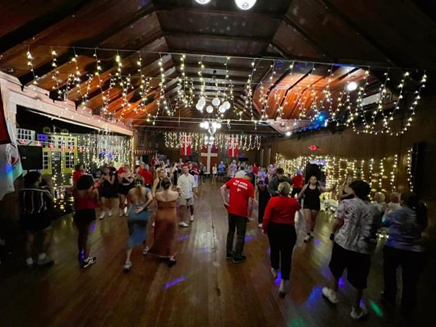
Bridging Hygge and the Grundtvigian-Nudge at Danebod
By Steve Olsen
The Danebod Folk School: There it stands in Tyler, Minnesota, like a sentinel overlooking miles and miles of verdant cornfields; the skyline punctuated by silos and wind turbines. The well-manicured lawn, stone monuments, and Danish flags flapping in the wind spread their open arms in welcome. But who would come here and why? It is probably not someone seeking adventure, romance, or gambling.
It is early afternoon and here they come, first one or two cars then groups. The weary travelers exit their vehicles, stretch a bit and secure their hats against the prevalent but fresh prairie winds. Those who are repeat attendees look around for assurance that everything is about the same as when they left last year. Soon they recognize a friend and are engulfed in extended interaction trying to catch up on the highlights of the last year. For those who are “first timers,” the reaction is often, “Is this the right place?” perhaps accompanied by that internal thought, “What on earth did I get myself into? I’m out of my comfort zone.” Their perception is spot-on, and the Danebod Folk Meeting Planning Committee accepts these reactions as challenges each year when planning the meetings, lectures, and other activities.
Each year, the planning committee reviews feedback from the surveys sent out just after everyone gets back home after the previous four-day session and, each year, we are gratified that the ratings are so affirming and the suggestions so helpful. The planning committee is faced with an awkward dilemma as we attempt both to endorse and challenge two gently opposing Danish pillars of social interaction – Hyggelig versus the Grundtvigian-Nudge, better known as the Folk School pillar, Lifelong Learning. Hyggelig smothers us with the familiar, the soothing candles, cookies, and laughter of close friends while the
Grundtvigian-Nudge gently challenges us to expand our understanding of the world, to enhance our abilities, to try new things, and to get up and start moving. This is the inviting challenge which we both wrestle with and enjoy.
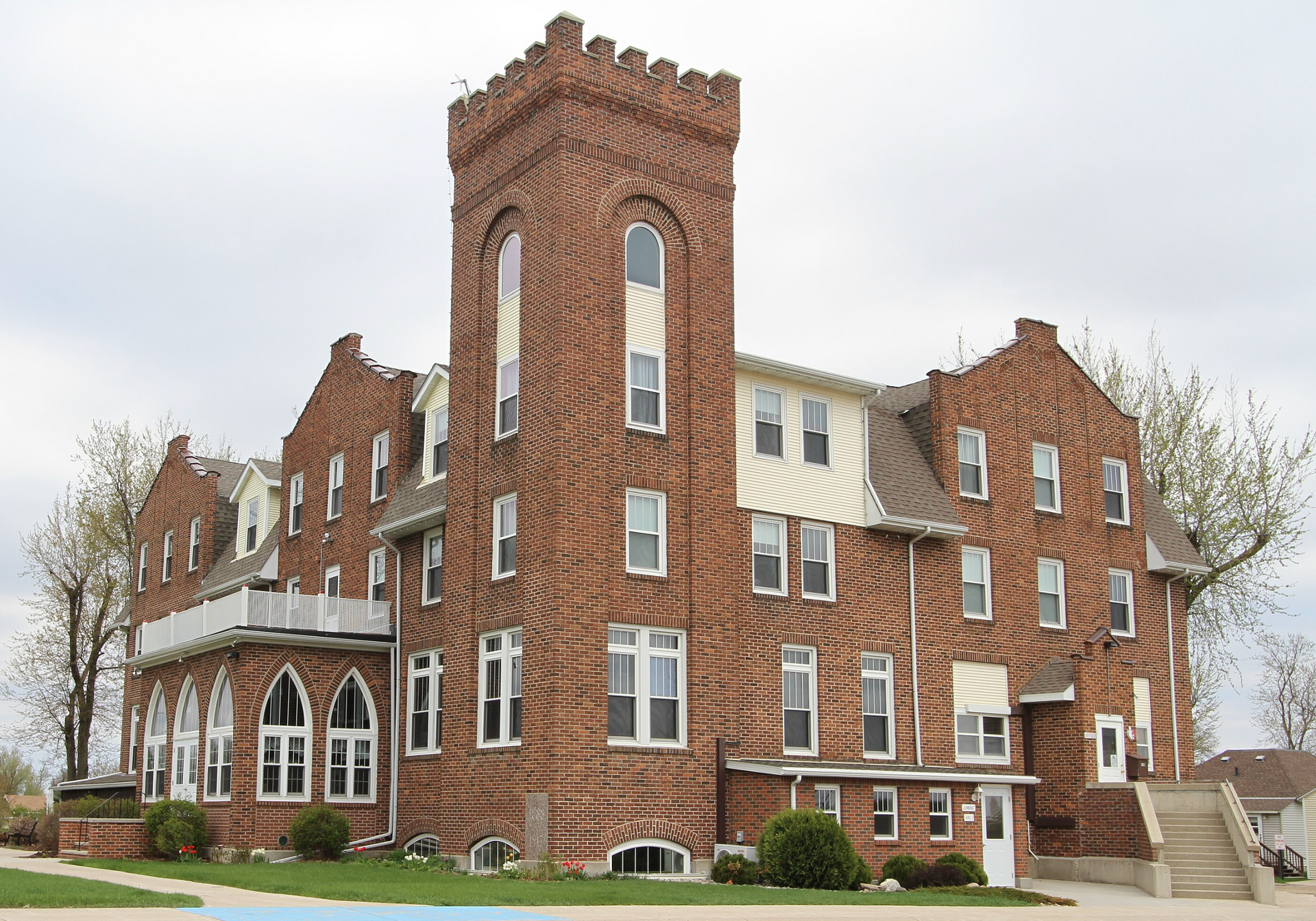
It is affirming to us on the planning committee when we receive such feedback as “I was going to skip the lecture on poetry, but I am so glad I didn’t. The lecture opened my eyes to a whole new way of looking at the world.” Or “I could care less about robots, but that lecture revealed a body of knowledge that I knew nothing about.” Participants at the Danebod Folk Meetings come with many expectations. We hope that you will bring yours to the next opportunity for Lifelong Learning next August at the Danebod Folk Meeting where we will tempt you with a whole new roster of lectures, activities, and, of course, Danish food. This is our invitation and a Grundtvigian-Nudge.
The Joy of Danebod
by Kay Linquist
At this year's Danebod Folk Meeting, I was asked to write some comments about Joy Ibsen for Church and Life. In my mind Joy and Danebod are intertwined. I said I would write about her because I knew that no matter what I wrote, Joy would have something nice to say. She is truly a “Happy Dane.” Someone commented she is “always smiling and brings a touch of class.” The same happy, classy nature characterizes Danebod.
Joy was born in Tyler, Minnesota, where her father Harald Ibsen was the Lutheran Pastor. Even though she was surrounded by Happy Danes, there was tragedy in her life. Whenever we are at the Danebod Folk Meeting in Tyler, we visit the place where her little brother Paul was buried. He died at two months old with some heart problems. It is also where her best friend Karen Ann Hansen, who died at age seven of acute appendicitis, was buried. And when Joy was young, another tragedy happened. Neighborhood friends Edward and Frances tried to cross the creek when the ice was already starting to melt. After much talk Frances decided to take a shortcut instead of going the long way around, but the ice broke, and she drowned. It was a devastating time for the whole community. Joy took these events in stride.
As a young woman, Joy attended Grand View University in Des Moines, Iowa. She had a passion for the work of N.F.S. Grundtvig, and she truly became a lifelong learner. Several years later, she spent two months in Denmark studying Grundtvig’s current relevance to modern life by interviewing thirty-two Danish Grundtvigians. After Grand View, she was given a full tuition scholarship and a job in the cafeteria at Shimer College, a very liberal university near the University of Chicago. When Joy arrived on campus at Shimer, she said, “I knew who I was and what I was about. When I left Shimer, I had only the vaguest notion.” But there’s little doubt that Shimer was where some of her happiest stories occurred. One of them, recorded in her book Here and Hereafter, is characteristic of her happy outlook. She wrote,
My job as waitress included serving formal dinners. In the first such event, while carrying a huge tray of blueberry pies, I came through the swinging doors of the dining room just as a waiter came hellbent from the other direction. A multi-tympanic-resounding crash! Both trays flew up, and the two of us landed on the floor, our bodies decorated with blueberry pie and surrounded by cascades of broken dishes. As was customary whenever the sound of broken dishes occurred in the dining room, the students broke out into applause. I stood up and made an elaborate curtsy while my coworker scraped pie off his shirt and pants. The food manager asked me to come to his office the next morning after breakfast. I expected at least a reprimand and maybe even being fired. Instead, I was promoted to the job of noon hostess and given a raise of 5 cents an hour. “Incompetence rewarded”.
At Shimer College, Joy also met John Mitchel Martin, a talented fellow student and poet whom she later married. They had three children together. She divorced John in 1978. In 1982, she walked the block to Unity Temple where the Discovery Group was meeting, and there she met Don Lenef. On Thanksgiving weekend 1987, Joy and Don were married in the home of friends. The wedding included Christian and Jewish heritage. Joy’s children and Don’s sons walked them down the aisle. It was a happy time. Joy and Don were married for 35 years, and Don died on November 8, 2022. Don was Jewish, never had a tree at Christmas, liked being indoors, and liked to cook. Joy is Christian, celebrates a real Scandinavian Christmas, wants to be out in nature, and doesn’t cook. Don became Danish by marriage.
After Shimer, Joy attended University of Chicago Divinity School, and she earned a certificate of lay ministry from the School of Theology, University of the South. But she had a richly eclectic career that included service as a case worker for public aid recipients in Chicago’s economically disadvantaged neighborhood of Woodlawn; teaching GED preparation to Vietnam-bound soldiers; teaching English literature and theater to students at St. Katherine’s/St Mark’s preparatory School in Davenport, Iowa; serving as chief planner for the Model Cities Program in Rock Island, Illinois; consulting and raising money for community, education, and art organizations; and heading development offices at Mount Sinai, Methodist, and Swedish Covenant Hospitals in Chicago. In Michigan’s Upper Peninsula, she taught piano lessons and served as church organist.
Normally people slow down in retirement. Not Joy. She published book after book, many of them personal and philosophical reflections, like Unafraid, which included sermon notes from her father, and Here and Hereafter, a memoir about life, death, and spiritual legacy. Other books explore societal questions, like Declaration of Interdependence and Pandemic Parables and the New Paradigm [which is reviewed below in this issue]. She even compiled a collection of Danish music and poetry in Songs of Denmark, Songs to Live By, and she has recently written a children’s book titled Reginald, the Cat Who Couldn’t Sleep!
As part of retirement in Trout Creek, Michigan, Joy and Don went to work renovating a lovely two-story home with a room perfect for piano recitals. She threw herself into the art and music culture of the Upper Peninsula by giving piano lessons, becoming involved in the Pine Mountain Music Festival, and participating in a local art show to provide opportunities for local artists. Each March, she took part in the “St. Urho” celebration of the fictional saint of Finland by crowning the king and queen. And, of course, she worked hard to support literary efforts, especially the two libraries, and she started a writing group. For fourteen years she was editor of Church and Life, doing most of the editing work at Rocky Shores, their cottage on the shores of Lake Superior.
Joy and Don’s homes in Trout Creek and Rocky Shores were really places for “hygge” (a cozy Danish lifestyle), especially with Don’s cooking and when Socrates, Don’s dog, joined in. The same is true of the place they moved to in Albuquerque. Joy and Don attended a nearby synagogue and enjoyed the Klezmer music where Don played the trombone. Joy joined the dancing, which was like the Danish folk dance.
Recently, Joy moved near Chicago recently where she is doing wood carving and has directed a version of “Broadway Musicals”. She writes, “Each life is work of art, a self-painting inspired by soul knowledge, life experiences and guided by the universal God. Sometimes at times of death, as well as at other times, we have an opportunity to see the eternity connection between the here and the hereafter.” From my perspective, Joy is the epitome of Grundtvigianism, especially Grundtvig’s idea that “Human First, Christian comes next”.
Joy Ibsen does indeed “enjoy life,” and I associate her with The Folk School.
Dateline Denmark
By Edward Broadbridge
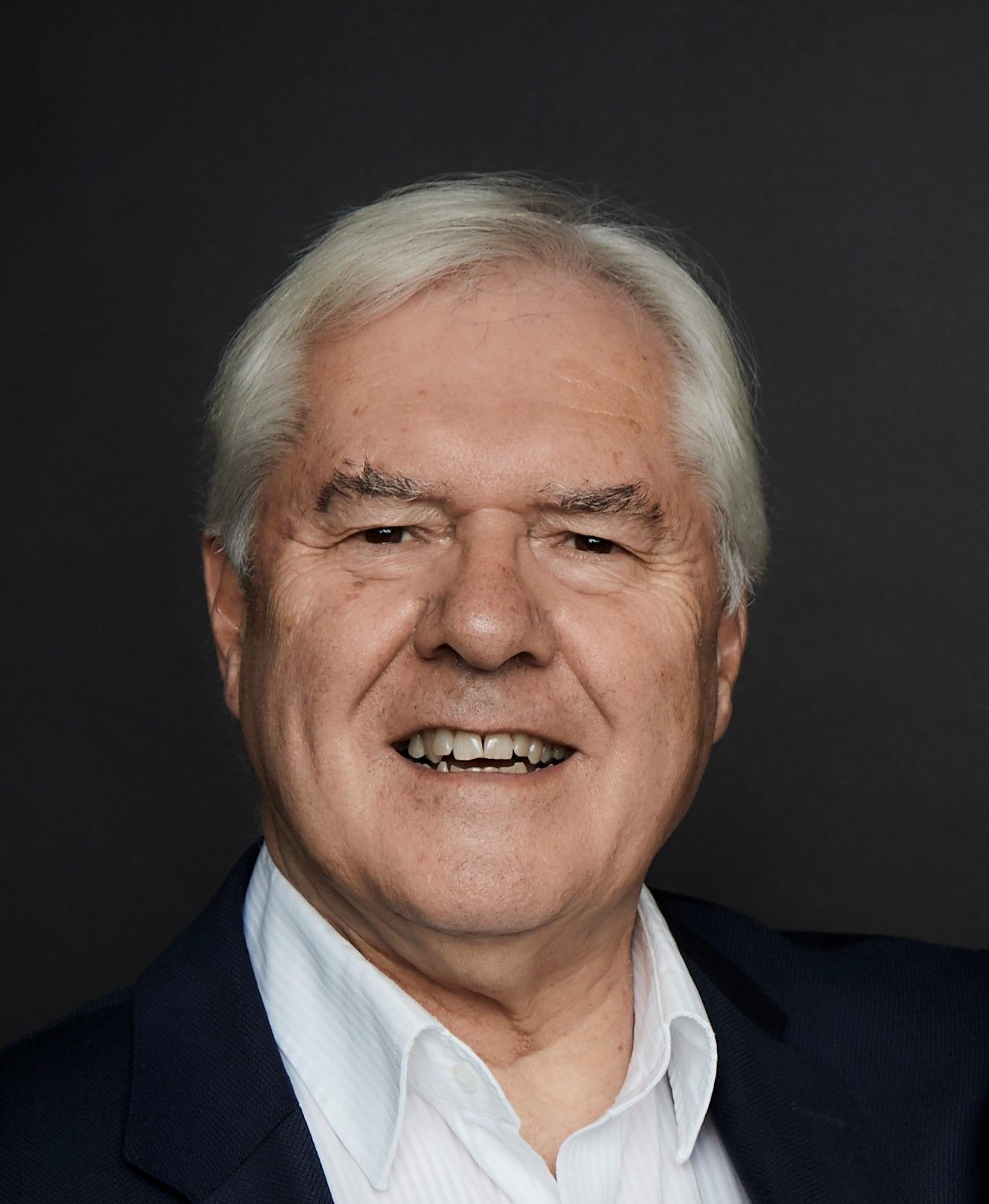
Grundtvig on the Prairie (Reprinted and adapted from the June and September 2025 issues of The Grundtvig Newsletter)
Back in 2010, Henrik Bredmose Simonsen travelled to Minnesota, Wisconsin, and Iowa with economic support from the Grundtvig Centre in Denmark to document life among the “Grundtvigian” Danish Americans.
He came home with twenty-two sound recordings, which have at last been made available with draft manuscripts in the Danish-American Archive & Library (DAAL) in Blair, Nebraska. The documents include:
· Audio files with transcriptions
· PDF versions of the transcriptions
· Individuals and groups interviewed by H. B. Simonsen.
Initially, the material was used in an exhibition entitled "Grundtvig on the Prairie." Henrik Bredmose writes, “There is of course a big difference between individual interviews; the long interview with Professor Mark Mattes from Grand View University, Des Moines, Iowa, is of interest to Danish theologians and church historians, while others contribute with a more general view.”
Simonsen offers a picture of the landscapes he visited. He writes, “Imagine driving mile after mile through the Midwest past maize fields and scattered farms only to arrive at a place with "Danish" high school buildings, including a tower in red stone, a church, a meeting house and a gymnasium. That was my experience back in 2010, the place in question being Danebod Folk School in Tyler, south-west Minnesota, where since 1946 the annual Danebod Folk Meeting takes place.”
The surprise did not diminish over a five-day stay. This was traditional people’s high school from morning till evening with talks, singing together, folk dance, and of course Danish food. Around 100 Danish-oriented Americans were gathered for the meeting, which for most was a reunion with friends and acquaintances.
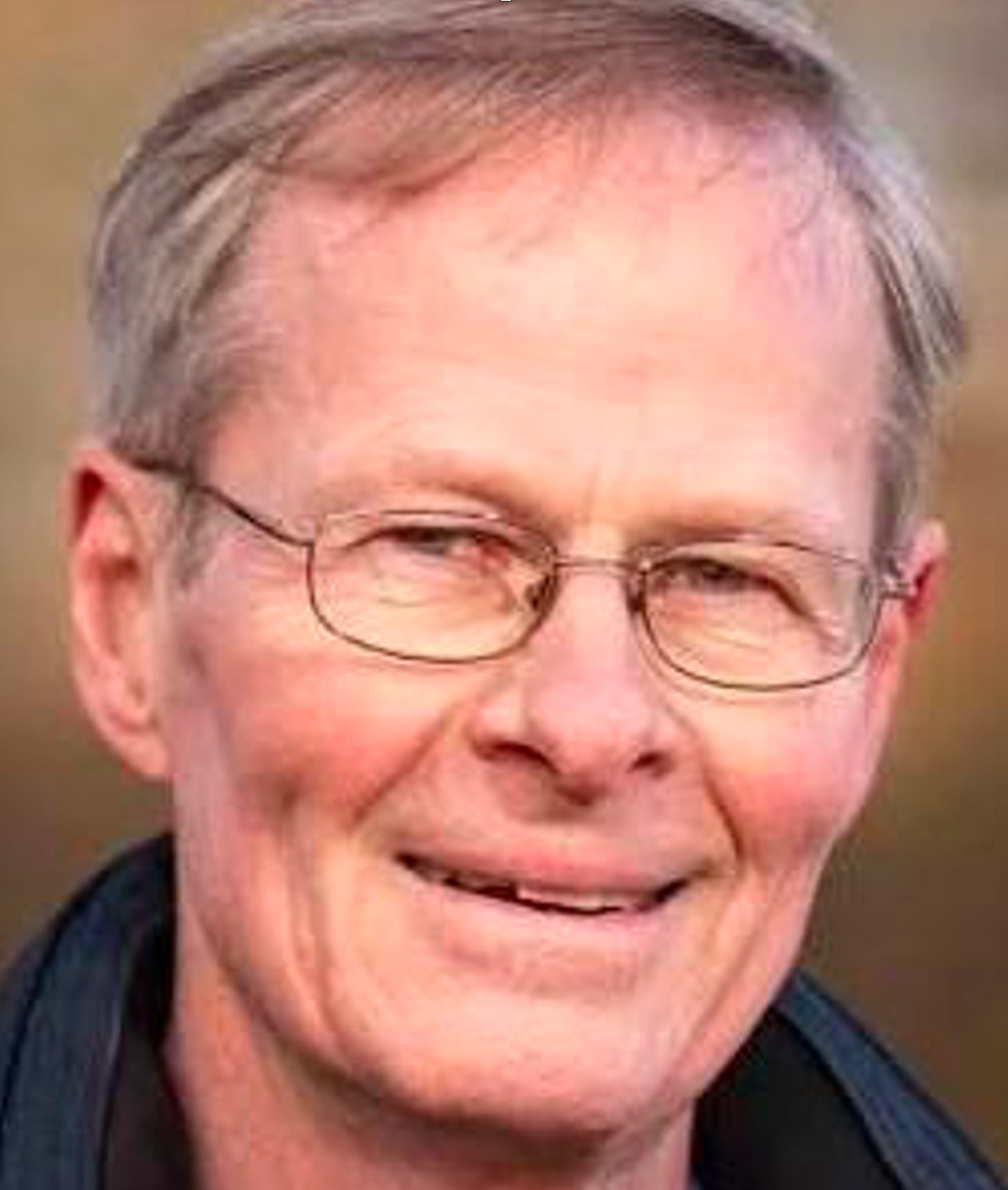
[Henrik Bredmose Simonsen (above) can be contacted at: hbsimon@mail.dk]
"I had the pleasure of interviewing some of the participants about being part of the Grundtvigian tradition in the USA," writes Simonsen. "Their description of the relationship to Denmark differed considerably. Some had a clear answer as to what lay in the word "Grundtvigian," while for others it was a question of having grown up in Danish-American small towns with names like: Viborg, South Dakota; Askov, Minnesota; Danevang, Texas. . . They knew the Danish traditions and the Danish world view. As one of them said most tellingly, 'We lived it, we never put it into words.'"
Educating the Appalachians with the Danish Folk School: The Life and Legacy of Olive Dame Campbell
by Madison Morrison
On October 4 and 5, 2025, the John C. Campbell Folk School celebrated its centenary anniversary. One of the earliest implementations of the Danish folk school in America, the John C. Campbell Folk school has long been revered for the way it helped educate Appalachian families. However, not sufficiently celebrated is its founder Olive Dame Campbell.
Olive Campbell and her husband, John C. Campbell, began studying the Appalachian region and the culture of its people in 1908. When her husband died in 1919, Campbell spent four years compiling The Southern Highlander and Their Homeland with her husband’s notes and published it in his name. After preserving her husband’s ideas, it was time to continue their shared work. So in 1922, she traveled to Denmark to study the Danish folk school model as part of an 18-month tour of Scandinavian countries. She was accompanied by Marguerite Butler, a friend and colleague she had met at the Conference of Southern Mountain Workers. This was no small feat. They traveled by train and wagon around Denmark and often encountered difficulty because they didn't speak Danish. It was highly unusual at the time for a woman to travel overseas unaccompanied by a man. But Campbell was on a mission.
At one point, Campbell and Butler lived as pupils for a month Askov Folk High School , fully participating in the school’s programming to gain firsthand experience. In a letter addressed to her friends in 1922, Campbell wrote, “Our visit to Askov makes us a bit restless to be in the city fascinating as Copenhagen [is]— and more keen than ever to get to the heart of our study.” When in Copenhagen, they also attended lectures at Borup’s Folk High School, which catered to trade union and industrial groups.
The experiences excited Campbell. She saw the Danish model as an opportunity to reach and educate a group of Americans whom previous missionaries and educators had struggled to reach. Scotch-Irish culture of Appalachia would serve as the basis of the school’s educational format. John C. Campbell was founded in 1925, after she secured the land and means to support the school, and, in February 1927, five years after her visit to Denmark, the Folk School began its first lessons in a weeklong experimental school session.
Olive Campbell gave a talk on history, a local forester named Leon Deschamps gave a talk on the “life of a tree,” another scholar spoke about public health, and Fred O. Scroggs lectured about archaeology. From the beginning, Campbell hoped to create a close family-like environment between staff and students like that at the Danish folk schools. The first classes were hosted in the farmhouse; students and faculty huddled around the warmth of a small wood stove. It was effective. By December 1927, the folk school had begun enrolling students in regular sessions. Classes ran from December until early spring, in order to allow for rural families to maintain their livelihoods.
Campbell stood out as a gifted educator. A fellow teacher, Louise Pittman noted that “Campbell was at her best in informal meetings with her students, perhaps before the open fire with a group or with one or two alone wherever chance brought them together." Campbell not only preached personal connection but also practiced it. In the early years of the school, Campbell did not take her $2,000 annual salary, even when she had previously loaned the school $3,000 (which she never received back). Campbell’s dedication to the work of the school was without question. Louise Pittman went on to say, “Wherever Olive Campbell touched life, she enriched it.”
Enrich it she did. While school numbers began with only seven students enrolled at the beginning of 1928, enrollment increased that same year when the school’s board of directors decided to allow for boarding
students. Still small in size, the school family of 18 would crowd into a farmhouse dining room to share their meals and their knowledge. From laundry and needlework to farm work and cooking, all activities were considered vital to a young person’s education. As time went on, the school fostered practical farm skills, craftsmanship, and community-building that helped Appalachian families thrive. By learning various trade skills, families earned supplemental income outside of their farming practices. The work of the school also preserved the craft and songs of Appalachian families. Rather than using education as a means of replacing the traditions and values of Appalachians, the folk school’s philosophy empowered and preserved Scotch-Irish culture.
“If the teaching is to enrich rural life,” wrote Campbell in a school newsletter, “it must be rooted in a deep belief in the country; not perhaps as it is, but as it may be: its power to satisfy; to offer a full life.”
Campbell’s strong belief in enriching rural life while honoring its culture is what allowed the school and its occupants to thrive. Today, the John C. Campbell Folk School celebrates its 100th year anniversary and while the school deserves to be celebrated, the woman who poured her lifetime into building it equally deserves celebration.
For further reading:
Campbell, Olive Dame. Appalachian Travels: The Diary of Olive Dame Campbell, edited by Elizabeth McCutchen Williams, The University Press of Kentucky, 2012.
DANCING IN THE CABBAGE PATCH – Olive Dame Campbell’s 1922 Letter on Danish Folk School Training
Making History: John C. Campbell Campbell Folk School
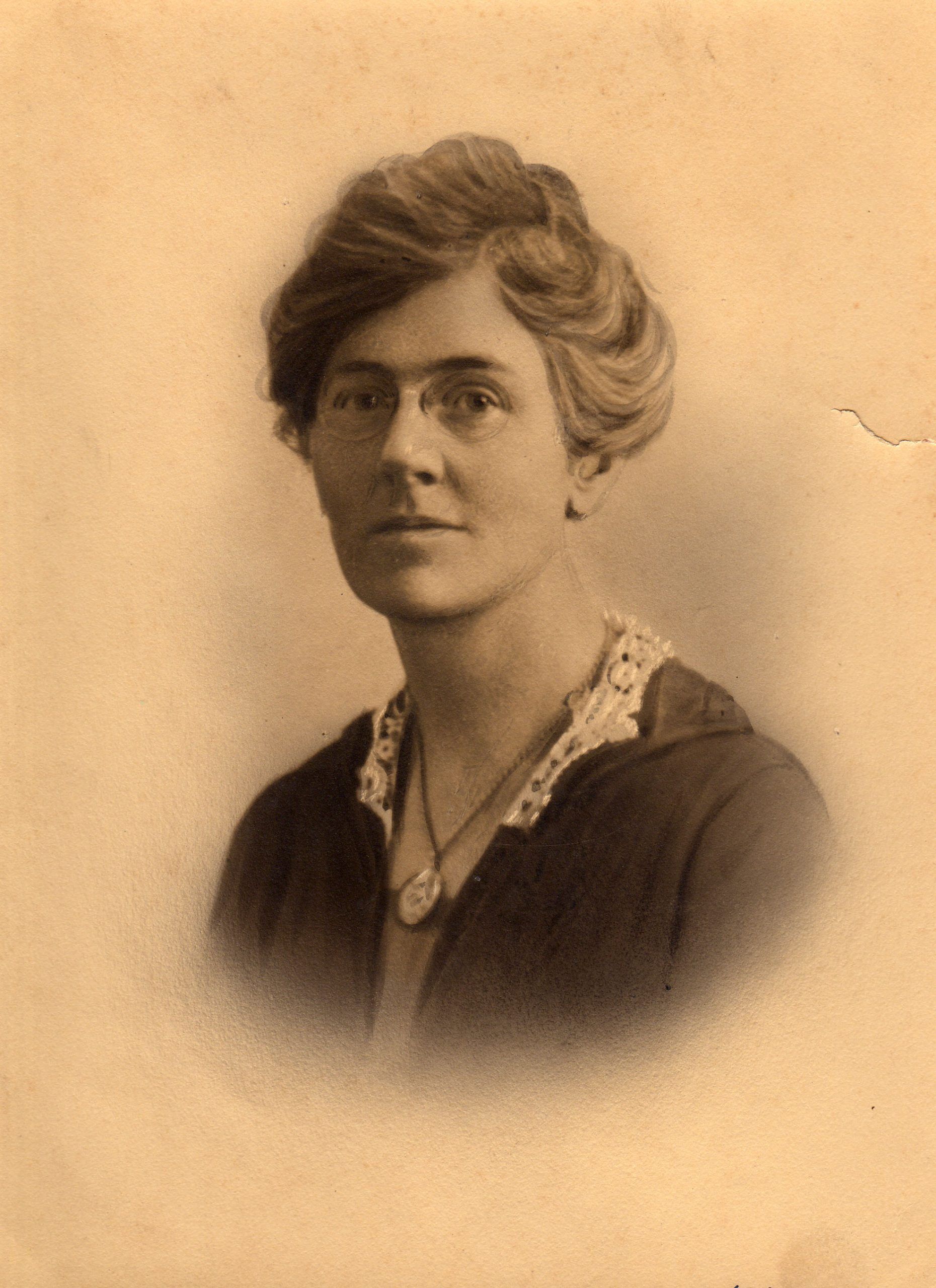
A Conversation with Chris Spicer about Folk Schools
by Maddie Benton

This fall, as we consider the significance of the Danish folk school and its impact particularly in America, I spoke to Chris Spicer, the former leader of the Folk Education Association of America. Spicer offered insights about the folk school and its continued significance and role in the modern community.
Spicer shared stories about his involvement in the folk school community, which he first learned about as an undergraduate. His experiences at Berea College, where the Folk Education Association of America began, and his interest in environmental education eventually led him to a position at John C. Campbell. He later became the leader of the Folk Education Association of America, an association he describes as a diverse mix of people and programs committed to experiential education.
I asked Spicer if he could define folk schools, and he laughed and said, "No." Given the diversity of folk schools, his reaction is understandable; they are nearly impossible to describe with a single, concrete definition. According to the Folk Education Association of America, folk schools began in Denmark around the mid-nineteenth century, modeled after Grundtvig’s idea about the importance of closing the “rift between life and [traditional forms of] learning.” In the early 20th century, folk schools began to form in the United States. They seek to unify “an individual . . . , cultural . . . , and democratic identity” by helping their
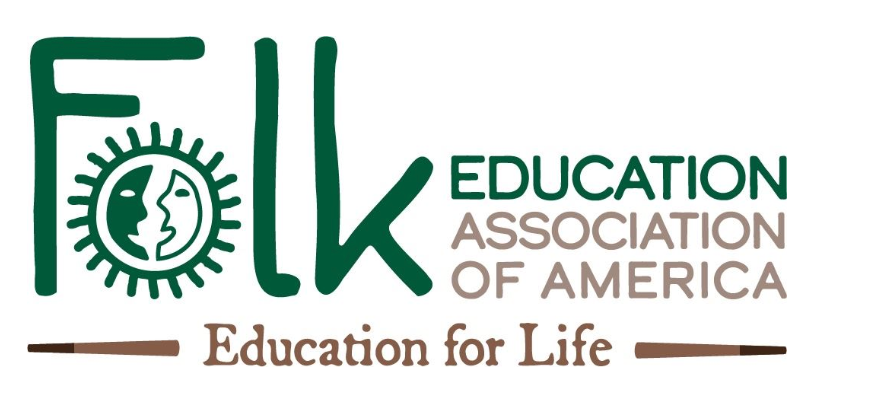
members learn “not just about…skills but also about human empowerment and educati[on] for participatory democracy…to inspire change for education and communities." Spicer elaborated on this definition by describing some of the central tenets of folk schools. Though he acknowledged folk schools are often characterized by their “non-competitive” atmosphere and lack of exams, Spicer instead defined them according to what he called “educational principles.” He noted that they are centers of “collaborative learning” where students are focused on “learning not only with people but also about other people” and “how to be . . . good civic-minded and democratic participant[s] in society,” echoing the FEAA’s motto of “learning for life.” Folk schools, according to Spicer, focus on educating the whole person to train them to meaningfully contribute to their communities.
Spicer’s definition highlights a key piece of the significance of folk schools: by educating the whole person, folk schools equip people to enter democratic discourse. Indeed, the folk school model is credited with transitioning Denmark to democracy. Though they are a fascinating piece of Danish-American history and culture, they are more than just an artifact and still play an active role in shaping the community today. Spicer noted that folk schools are particularly helpful in helping communities overcome prejudices. Because folk schools involve learning about the people you study with, they involve learning about those who are different from you and, as Spicer put it, crossing “social, racial, and political divides” to overcome “deep and long historical differences.” The folk school’s emphasis on educating the whole person means that it is uniquely equipped to bridge these gaps and equip people to engage in democratic conversation. Though they are a fascinating piece of Danish-American history and culture, they are more than just an artifact and still play an active role in shaping the community today.
Finally, though some might consider the folk school model dated, Spicer discussed the way that modern technology has helped strengthen the folk schools. In the last twenty years or so, the folk school as seen a remarkable resurgence, one that Spicer largely credits to new technology. The internet has introduced people to the idea of folk schools and allowed them to learn about them in ways that was not common in America before the internet. Particularly thinking about the challenges and benefits of AI, Spicer notes that it can serve as a tool to connect people to the folk school. The folk school’s work of holistic education is not negated by AI, Spicer suggests, because AI as we currently understand it only touches on the “intelligence” “component of the human experience.” Folk schools are uniquely designed to “maintain humanity in a highly technical world,” a goal that AI simply cannot achieve.
Ultimately, my conversation with Spicer proved a useful reflection on the significance and continued legacy of the folk school in America. As we celebrate the 100th anniversary of John C. Campbell, where Spicer began his own journey, we can reflect upon and appreciate the rich and storied history of the folk school, while also looking forward with eager expectation to the ways that it will confront new challenges of promoting democracy and adapting to technology. The folk school provides a useful model as we strive to be well-rounded human beings who seek to better love God and one another.
A Review of Pandemic Parables and the New Paradigm by Joy Ibsen
Reviewed by Ana Wright
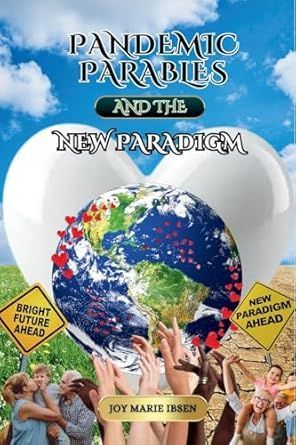
In Pandemic Parables and the New Paradigm, written during the COVID-19 pandemic and published earlier this year, Joy Ibsen offers a unique perspective on the social, cultural, and spiritual effects of the pandemic, and how we, as members of a post-Covid world, should respond. The book is divided into two distinct sections: a thoughtful reflection on the past and a hopeful commissioning for the future. In the first section, Ibsen shares fictional stories of life-altering experiences that people faced during the pandemic, and she urges us to consider what we can learn by contemplating both these stories and our own pandemic stories. Each scenario is thoughtfully interwoven with a sermon based on a Biblical parable, demonstrating the importance of spiritual transformation in facing challenging circumstances. The second section of the book is a discussion of “The New Paradigm,” a term coined by Peter Lorie to describe the current shift in humanity’s collective perspective after the pandemic, which Ibsen predicts will help us to “create a new earth” in which there is increased “harmony between people, technical advancement, and spirituality, growth, and transformation intertwining with one another” (183). Thus, by bringing together moving personal stories with this inspiring call to personal and collective growth, Ibsen provides an appraisal of the pandemic that is both honest and hopeful.
Ibsen points out that although many books have been published that examine the causes, events, and statistics related to the COVID-19 pandemic, far less has been written that explores the more personal, less quantifiable effects of the pandemic in the lives of individuals.
Pandemic Parables and the New Paradigm, then, fills a legitimate gap in publications related to COVID-19. Although the scenarios in the first section of the book are fictional, they resemble scenarios that many of us experienced or heard about during the pandemic, and Ibsen’s sensitive, engaging storytelling makes her characters seem like real people. Considering their stories is, in some ways, an exercise in empathy. Rather than report numbers, Ibsen reminds us that those who suffered in the pandemic were human beings, and their stories should be shared.
The sermons in this section are just as important as the stories that they are woven into. Each one illuminates a biblical parable with thoughtful, practical insight, and Ibsen cites her father, Harald Ibsen, and the theologian and educator NFS Grundtvig as primary inspirations for these teachings. Indeed, Grundtvig’s four principles, which Ibsen summarizes as “love life, love nature, love people; and love learning” (183), are evident throughout. By honoring each other, expressing gratitude for our lives, and seeking personal growth, we pave the road to a brighter future. To quote Pastor Maria, the fictional pastor who delivers the sermons, “with God’s help, we can create a new world built on a foundation of love, deep gratitude, respect, and concern for all people” (46).
In the second section, which discusses the New Paradigm, rather than intertwining her insights with real-world stories, Ibsen switches to a more didactic tone, describing each element of the New Paradigm and referencing the teachings that have informed her own reflections. The content of this section is fascinating, and I was led to reflect on how the principles of the New Paradigm could benefit my own life. I did note, however, that the separate headings for each topic made the presentation feel slightly disjointed, and I found myself yearning for a more cohesive organizing structure to help focus the impact of her significant, almost prophetic, message to modern society.
This section is followed, however, by a detailed and very well-organized Appendix. Ibsen provides a biography of Harald Ibsen's writings, and a description of N.F.S. Grundtvig and the Folk School educational model which he established. She even includes a speech from President Obama honoring the impact of Grundtvig’s work in America! The appendix offers helpful background information for the book, and it illuminates the significance of the Grundtvigian tradition for those who may be unfamiliar with it. This is particularly important because, as she predicts, “I feel we may well be rounding the bend and making progress toward a more humane and spiritual world, one which resonates with the four Grundtvigian principles” (196). Indeed, we all have much to learn from these principles, and Ibsen’s work represents them well.
Ultimately then, the book’s message of individual wholeness, communal unity, and spiritual light shines brightly in our dark and divided world. Ibsen reminds us that while there is much to lament, there is also much to celebrate, and we have the power to make the world a better place. “What a wonderful time to be alive!” (183) she exclaims, and I am inclined to agree.
Meet the Church and Life co-editors
Maddie Benton
I am a senior at Samford University majoring in English with a concentration in Creative Writing and a minor in History. I chose these areas of study to learn to be a better thinker, communicator, student of the past, and loving neighbor. I have always loved writing stories; writing enables us to think critically unlike any other medium, generating and refining our ideas as we put pen to paper. Writing also serves as a conduit for connection, enabling us to learn the intricate details of other cultures and to better empathize with those unlike ourselves. I have always loved studying the past, and one of my favorite things about writing is the way it connects us across history. We can read stories from centuries before and get a glimpse into a world gone long before we were born. Writing can also serve as a powerful act of worship as we write in a way that glorifies God by honoring the people we write about and the stories we communicate. Because of these powerful tenets of writing, I am thrilled to work with Church and Life, using writing to connect cultures and explore rich Danish history, especially in relation to the church and its storied past.
I love not only writing but also teaching and encouraging others to be the best writers they can be a role I have been able to fulfill as a Creative Writing editor for Samford’s peer-reviewed journal,
Wide Angle, and co-director of the Samford's Writing Center. I hope to continue to grow as a writer in graduate school and become an author and perhaps a professor, telling the stories of the past to the present and teaching those around me that anyone can write and everyone has something meaningful to say.
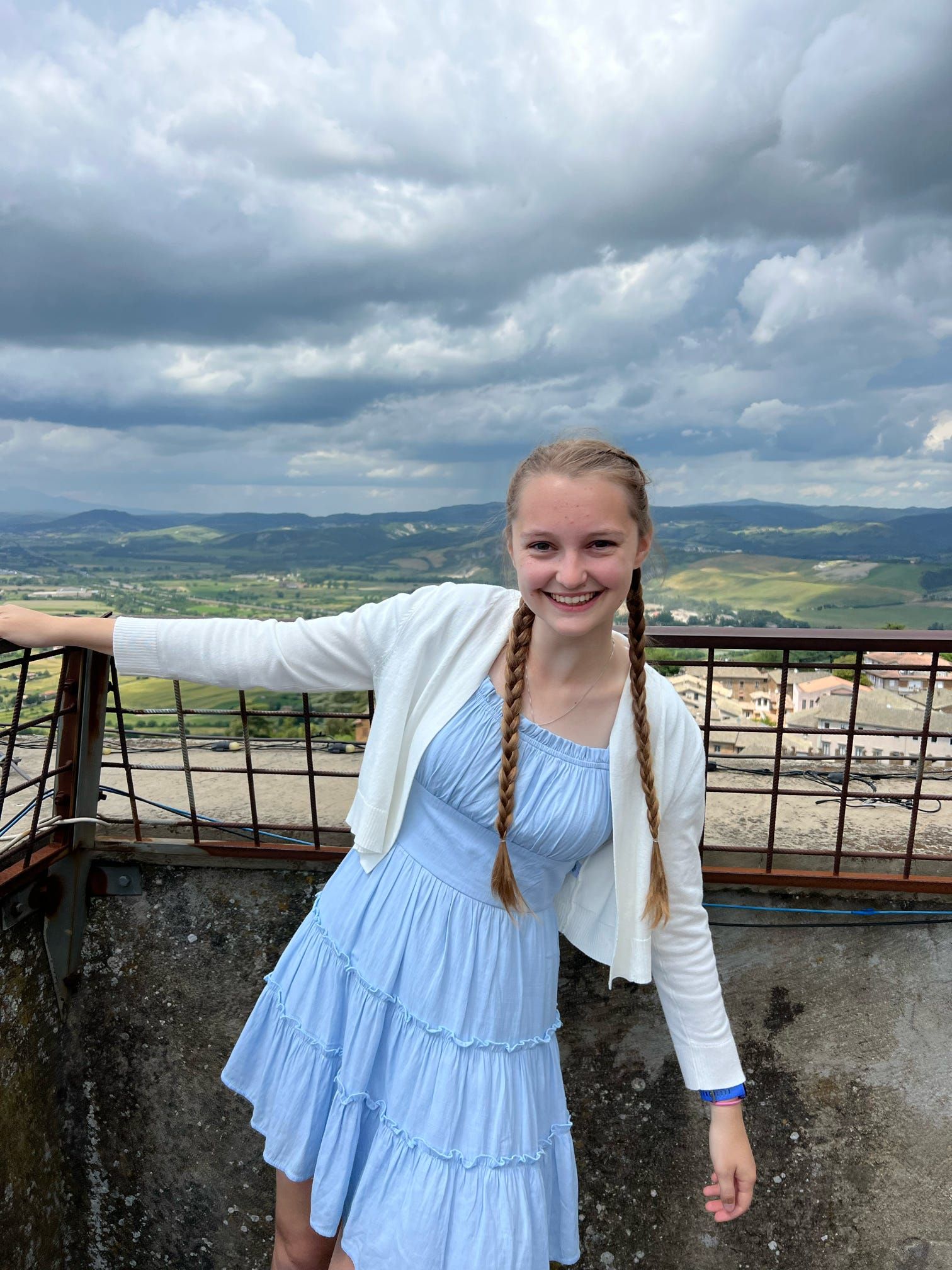

Madison Morrison
I am an English major at Samford University with a special interest in Philosophy and Biblical Studies. As the author of two faith-based newsletters on Substack, I enjoy exploring how faith and culture intersect with one another in the modern day.
Having spent half of my life in the sunny state of California and the other half in Georgia, I embody a blend of two vastly different cultures. This background is, in large part, why I am eager to explore how Danish- American culture and community traditions are preserved in America through Church and Life. I have a deep appreciation for how two places can shape a unique perspective on life and the world.
I hope to tell stories that translate the vivid life and culture that exists beyond the page as I contribute to Church and Life.
Ana Wright
I am a senior English major at Samford University, with minors in Biblical Studies and Music. I chose this path of study because I believe that the stories people tell and the songs that they sing offer windows not only into their individual lives, but also into the cultures and times they inhabit. I am fascinated by the interconnectedness of language, culture, and religion, and in our increasingly globalized modernity, I think it is more important than ever to honor and celebrate cultures that are different from our own. By studying and sharing stories and songs, I hope to expand my perspective on the beauty and diversity of humanity and better understand what my own place within it is as a writer, musician, and lover of God and people.
I was born and raised in the backwoods of Alabama, in the same house that both my father and grandfather were raised in, and I grew up listening to family legends and running wild in the woods around our property. This fostered a deep appreciation for rootedness and the importance of place in shaping identity and worldview.
My mother, however, is descended from one of the earliest settlers of The Bahamas, where she was born and raised but left behind when she married my dad. Watching her continually adapt to the culture of Alabama while still treasuring her own heritage has shown me both the impact of being uprooted from one’s place of origin and the importance of remembering and sharing stories to preserving one’s cultural identity.
I am incredibly grateful, therefore, for the opportunity to contribute to
Church and Life, not only to learn more about Danish folk tradition and the Danish-American community, but also to get to play a part in sharing meaningful stories and celebrating Danish culture, because I know how important such things are. I have much to learn from the Grundtvigian tradition, and I hope that through this experience I will learn how better to live a truly simple life, with a merry heart.
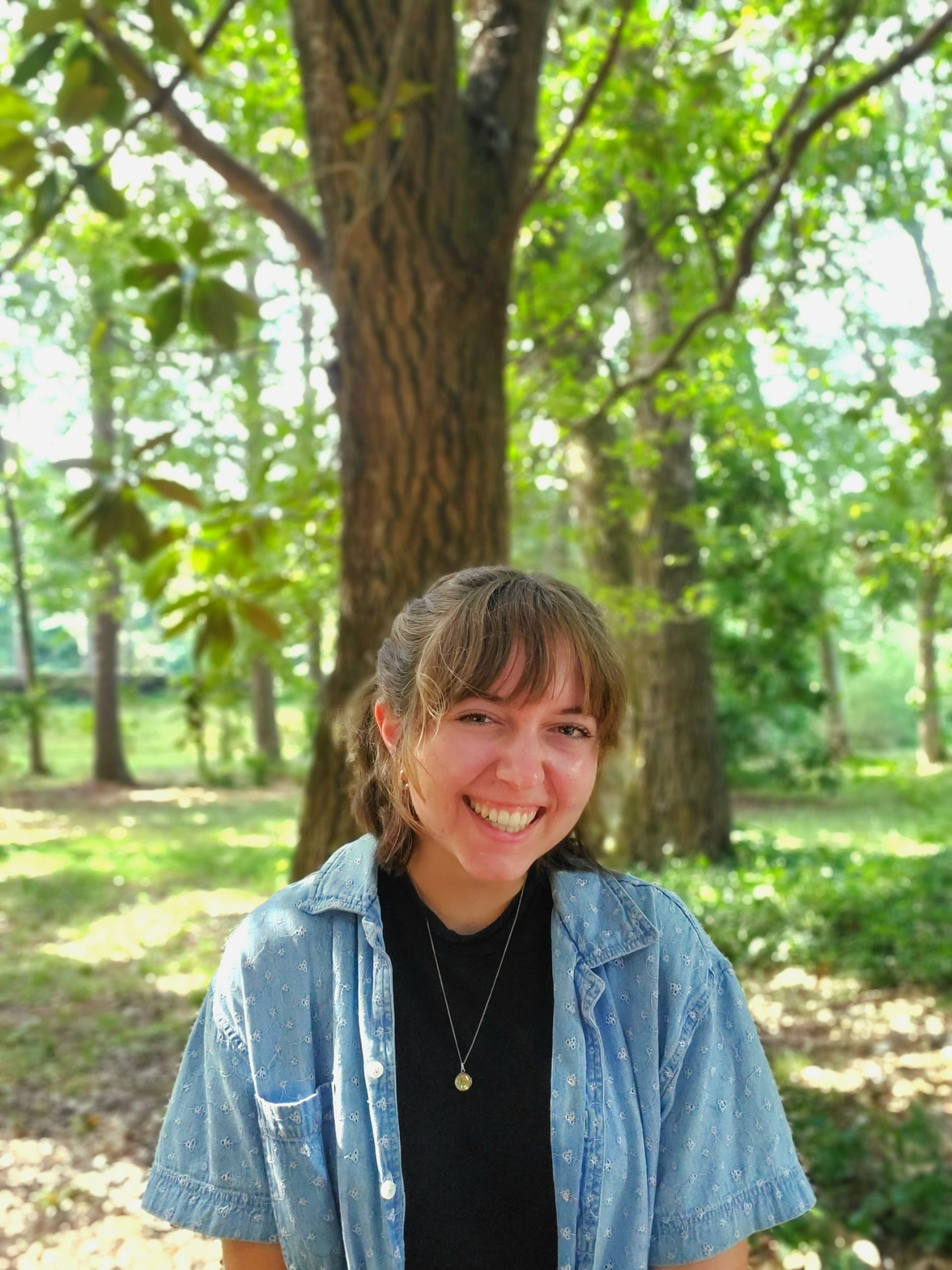
Postscript: The Heart, the Head, and the Hands . . . Education and Democracy
By Brad Busbee
On October 7, my department at Samford hosted an event about Folk School education. We called the event "The Heart, the Head, and the Hands: A Roundtable on Education and Democracy" and, as the title suggests, our primary goals were to tell the story of the journey of the Danish folk school idea from the mind of N.F.S. Grundtvig to America and to talk about how folk schools might be a solution to the problems of a divided society. The title also emphasized other ideas central to Grundtvig's ideas about education, one being the importance of an open, happy heart and the second, the importance of shared physical activity. We wanted to stress the necessity of physical proximity in learning and in building community.
The presenters came as a group of five to Alabama at the end of a whirlwind tour. They had traveled from their homes in Denmark, Tennessee, and Washington first to Highlander Research and Education Center in Tennessee for the school's annual Homecoming event, then to John C. Campbell for its 100th anniversary, then to the Alabama Folk School, where I met them and accompanied them on tours of the Farm School, Environmental School, and Folk School. Three of the five travelers made it to Samford to take part in the roundtable. One of the presenters was my long-time friend Anders Holm, who is a professor of Theology at Copenhagen University and an expert on Grundtvig (his book The Essential N.F.S. Grundtvig has been translated into nine languages). He was there to talk about ideological foundations. Another presenter was the Reverend Allyn Steele, Co-Director of Highlander Research and Education Center in Tennessee (the famed folk school where Martin Luther King, Jr., and Rosa Parks, among others, studied). Steele described the folk school as a form of faith in action. And the third presenter was Daniel Waid Marshall, the Director of the Sand Mountain Cooperative Education Center in Alabama (which was inspired by Highlander). Marshall talked about his new school, how it works, and why it's important.
It's unusual to see a large crowd of university students gathered in a lecture hall on a Tuesday night, but they came and had lots of questions. I introduced the presenters and asked the audience to bear in mind the central question of the night: What does education have to do with democracy? I then handed the microphone off the presenters so each could tell about themselves and their perspective on folk schools. Then, the crowd began to ask questions, and things got interesting.
I've known about folk education for some time now, but I was surprised by some of the questions, which revealed anxiety about community and identity in the current context. Some students wondered about the feasibility of the model described. Does it work with diverse student populations? How is it financially viable? What benefits are there to a career? I'm sure that readers who know much more than I do about the folk school tradition will nod knowingly at these kinds of questions. They're the ones we anticipate; they’re reasonable but a little hard to answer.
Professor Holm reminded us about Grundtvig's initial motivations. At the time, Denmark had a new constitution, and Grundtvig worried that, without education, rural farmers would not have an equal say in their government. He believed in the testament of living communities and the power of tradition as keys to his understanding of the Christian faith and to education. So he conceived of a new kind of education that would be deeply democratic. Students would work with their hands and talk with their hearts and thereby learn from one another. His followers would coin the truism that "demokrati er dialog." And if folks today are wondering if people in society today are losing the ability to have meaningful dialogue, we might find a way forward through the folk school model of education.
Reverend Steele told the compelling story of Highlander, how -- like Olive Campbell--Miles Horton and others travelled to Denmark to learn about the Danish folk school and came back to American with a set ideas that appealed to them. For Horton, that idea is that education should be for the common good. To establish it, he believed that there has to be useful, constructive conflict --the sort of tension that Steve Olsen and the planners of Danebod work hard to cultivate. The question is, how do we manage those tensions? Students wanted to know, and the question seemed to make some of them uncomfortable.
Daniel Waid Marshall brought these ideas together. He told how he had read Miles Horton's biography, The Long Haul, and it had changed his life. He told about his upbringing in California, early teaching career in New York, and his decision to move to Alabama and open a folk school. He asked the students if they realized that their grandparents and great-grandparents were part of many overlapping organizations that brought them into everyday interaction with other people, outside of their places of work and worship. And he asked them why it is that we isolate ourselves from one another today. For Marshall it is a matter of physical proximity, and the folk school is a way for people to see each other as people, each valuable in their own special way.
These stories and the ones shared in this issue about Danebod and John C. Campbell are reminders about the power of purposeful, joyful community.
Gifts to Church and Life
Supporting contributors: ($21-50)
Edmund Clausen
Marilyn and Bill Gift
Sustainers (more than $ 50)
John F. Rasmussen
Lynette Rasmussen
Janet Jensen

